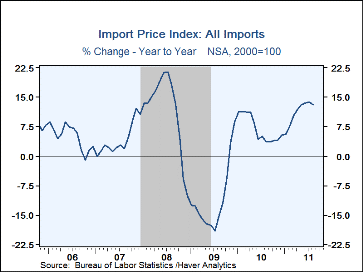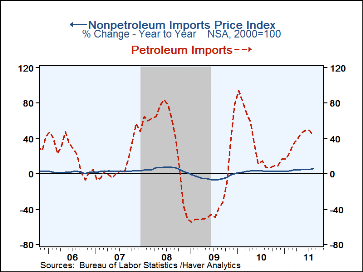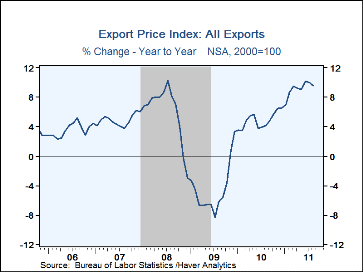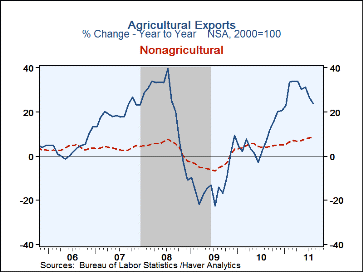 Global| Sep 13 2011
Global| Sep 13 2011U.S. Import Prices Decline With Lower Oil Prices
by:Tom Moeller
|in:Economy in Brief
Summary
Overall U.S. import prices fell 0.4% last month after an unrevised 0.3% July gain. Consensus expectations had been for a 0.8% decline. Year-to-year, the lower value of the U.S. dollar as well as higher oil prices have raised imported [...]
Overall U.S. import prices fell 0.4% last month after an unrevised 0.3% July gain. Consensus expectations had been for a 0.8% decline. Year-to-year, the lower value of the U.S. dollar as well as higher oil prices have raised imported price inflation. The 13.0% increase since last August was nearly the strongest since mid-2008.
Petroleum prices fell 2.1% as Brent crude oil fell m/m to an average $110.68 per barrel (+43.2% y/y) versus the high of $122.68 during April. Non-oil import prices rose 0.3% and by 5.5% y/y. (The y/y change in non-oil import prices during the last ten years has had an 81% inverse correlation with the nominal trade-weighted exchange value of the US dollar vs. major currencies.)
Imported food & beverage prices fell 0.8% last month (+14.4% y/y) for the third decline in four months. However, prices for non-oil industrial supplies rose 1.0% (16.3% y/y). Prices for non-auto consumer goods rose 0.3% (2.0% y/y) while apparel prices jumped another 0.8% (9.1% y/y). Also firming were furniture prices, up 0.3% (5.5% y/y), but home entertainment equipment prices again fell 0.6% (-6.6% y/y). Imported auto prices were roughly unchanged (+3.9% y/y) while imported capital goods prices also were about unchanged (1.4% y/y). Computer & peripherals prices again fell moderately (-5.0% y/y). Excluding computers, capital goods prices rose 0.3% and by a strengthened 4.1% y/y. They ticked up just 0.5% last year.
U.S. export prices rose 0.5% as agricultural prices jumped 2.2%. They reversed most of the July decline and were up by one-quarter versus last year. That gain was accompanied by a 0.3% increase in non-agricultural goods (8.1% y/y). Prices of industrial supplies increased 0.4% and were up 19.2% y/y. Capital goods price gains have improved moderately. To the upside, nonauto consumer goods prices rose 5.9% y/y compared to a 0.3% gain during all of 2009.
The import and export price series can be found in Haver's USECON database. Detailed figures are available in the USINT database. The expectations figure is in the AS1REPNA database.
Financial Crisis, Unconventional Exit Strategies, and Agents' Expectations from the Federal Reserve Bank of Kansas City is available here.
| Import/Export Prices (NSA, %) | Aug | Jul | Jun | Aug Y/Y | 2010 | 2009 | 2008 |
|---|---|---|---|---|---|---|---|
| Imports - All Commodities | -0.4 | 0.3 | -0.7 | 13.0 | 6.9 | -11.5 | 11.5 |
| Petroleum | -2.1 | 0.7 | -2.4 | 43.5 | 28.4 | -35.9 | 37.7 |
| Nonpetroleum | 0.3 | 0.1 | -0.1 | 5.5 | 2.8 | -4.1 | 5.3 |
| Exports - All Commodities | 0.5 | -0.4 | 0.2 | 9.6 | 4.9 | -4.6 | 6.0 |
| Agricultural | 2.2 | -3.9 | 0.7 | 23.9 | 7.9 | -12.8 | 21.6 |
| Nonagricultural | 0.3 | 0.1 | 0.2 | 8.1 | 4.6 | -3.7 | 4.5 |
Tom Moeller
AuthorMore in Author Profile »Prior to joining Haver Analytics in 2000, Mr. Moeller worked as the Economist at Chancellor Capital Management from 1985 to 1999. There, he developed comprehensive economic forecasts and interpreted economic data for equity and fixed income portfolio managers. Also at Chancellor, Mr. Moeller worked as an equity analyst and was responsible for researching and rating companies in the economically sensitive automobile and housing industries for investment in Chancellor’s equity portfolio. Prior to joining Chancellor, Mr. Moeller was an Economist at Citibank from 1979 to 1984. He also analyzed pricing behavior in the metals industry for the Council on Wage and Price Stability in Washington, D.C. In 1999, Mr. Moeller received the award for most accurate forecast from the Forecasters' Club of New York. From 1990 to 1992 he was President of the New York Association for Business Economists. Mr. Moeller earned an M.B.A. in Finance from Fordham University, where he graduated in 1987. He holds a Bachelor of Arts in Economics from George Washington University.










